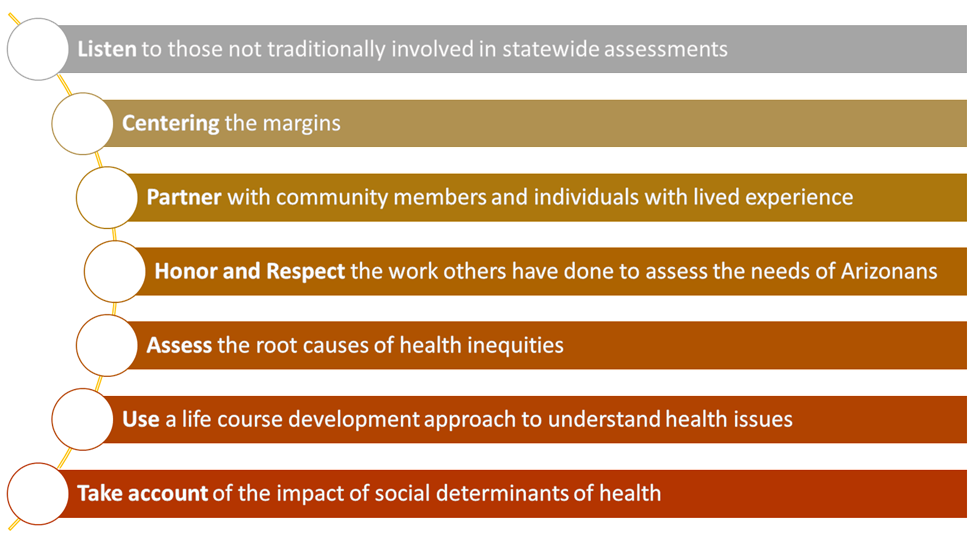By Martín F. Celaya, MPH, Arizona Department of Health Services
Arizona is a state well known for its diverse geography and vibrant communities. With a population of more than 7.3 million people, the state is widely characterized by its arid desert landscapes, including iconic landmarks like the Grand Canyon, captivating mountain ranges, and beautiful coniferous forests. Urban centers like Phoenix, the state’s capital, Tucson, and Flagstaff, vibrant rural and border communities, and 22 tribal nations contribute to the state’s cultural, historical, and economic makeup. Arizona also plays a significant role in immigration and policy since its shared border with Mexico (consisting of numerous communities like Douglas, Nogales, and San Luis) makes it a focal point in national political debates. In addition, the state has been involved in refugee resettlement efforts, providing a new home for individuals and families and thereby enriching the state’s cultural tapestry.
Figure 1. Principles are Integral to the Needs Assessment Process

A Broad, Inclusive Needs Assessment Steering Committee that Represents the Diversity of People Served is Vital to the Needs Assessment Process
Conducting a comprehensive needs assessment in Arizona requires using a multidisciplinary and culturally competent approach responsive to the state’s diverse geography, cultures, and communities. Establishing a needs assessment steering committee composed of representatives of Arizona’s MCH populations and providers was the first step in Arizona’s 2020 needs assessment process. Committee members represented state agencies, nonprofit organizations, advocacy groups, families, and other stakeholders. The intent was to include the people and organizations most suited to address the needs identified in the assessment.
The Work of the Steering Committee
The needs assessment steering committee met on a quarterly basis to perform a range of tasks in the needs assessment cycle. As needed, the committee:
- Guided the needs assessment process
- Provided feedback on data collection approaches and tools
- Recommended community groups and individuals to participate in community forums
- Leveraged existing partnerships to participate in assessment activities
- Promoted needs assessment methodologies for data collection
- Contributed input into the prioritization process for Arizona’s Title V Program.
Aligning Needs Assessment Methodologies with the Title V Program Principles of Inclusion
The Arizona Title V program was focused on the assessment’s seven overarching principles and values (described in Figure 1) as they designed methodologies for conducting needs assessments. The program sought to ensure that communities not typically involved in providing feedback related to the needs assessment process were provided the opportunity to do so and have suitable venues to give their input. It was important to consider the ways that these communities would be most comfortable in voicing their feedback.
In addition, the Title V program was adamant that the priority areas for Arizona’s 22 tribal nations needed to be included in the needs assessment. Thus, the Title V program staff engaged in meaningful and intentional partnerships with Diné College at the Navajo Nation and the Tribal Epidemiology Center in the Intertribal Council of Arizona to support tribal MCH needs assessments. Tribal assessments were intended to stand as their own MCH needs assessments to support the tribes while also complementing the overall statewide needs assessment.
Intergovernmental and contract agreements spanning five years were executed with the ultimate purpose of strengthening state, tribal, and community partnerships to
- Systematically collect information—using methodologies that are respectful to the community’s values, traditions, and sovereignty;
- Identify priorities; and
- Improve health outcomes for MCH populations in their communities.
Lastly, the University of Arizona’s Mel and Enid Zuckerman College of Public Health was also engaged in the needs assessment, providing spaces for families and youth from various communities (youth, community health workers, refugee, LGBTQ+, Latino and Black families, and families with special healthcare needs, amongst others) to talk about their health needs and experiences using health services. Three separate approaches were used: river of life planning, focus groups and individual interviews, and community forums.
The needs assessment included seven different methodologies or approaches to collecting and understanding the need for preventive and primary care services for the MCH populations in Arizona. Each methodology complements the other because each uses a different data source, engages different types of stakeholders, and takes place in different parts of the state. The intent is to ensure the needs assessment is as inclusive and comprehensive as it can be. Figure 2 shows each methodology employed in the needs assessment.
Figure 2. Needs Assessment Methodologies

Conclusion
Arizona’s collaborative and inclusive community-centric approach to the MCH needs assessments serves as a model for public health initiatives. Despite the program’s effort to be as inclusive and collaborative as possible, the assessment still missed some important communities in the state, such as the mining, farmworker, and unhoused communities. For the 2025 needs assessment, Arizona will build on its previous efforts to reach these and other communities that were missed and integrate family and young advisors into the steering committee to introduce diverse perspectives, encourage a holistic understanding, and ensure that the Title V program’s priorities are relevant and address diverse family needs. Planning efforts for the 2025 needs assessment kicked off on April 7, 2023, with the new steering committee. Arizona’s commitment to transparency, accountability, and ongoing collaboration sets a new standard for fostering healthier and more equitable MCH outcomes, paving the way for a future where community-centric approaches become the norm.
For more detailed information on Arizona’s MCH needs assessment, access the published reports
